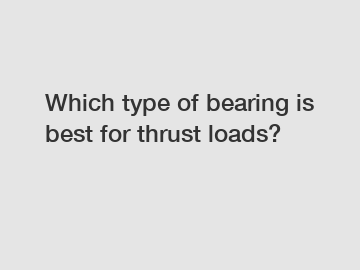Which type of bearing is best for thrust loads?
Which type of bearing is best for thrust loads? The answer lies in the specific requirements of the application. In order to determine the most suitable bearing for thrust loads, it is essential to analyze various factors such as load capacity, speed, precision, and operating conditions. Let's delve into the details to understand the rationale behind the choice of bearings for thrust loads and its significance in different industries.
When it comes to handling thrust loads, there are two primary types of bearings that are commonly considered – thrust ball bearings and thrust roller bearings. Each type has its own unique characteristics and suitability for different applications.
Thrust ball bearings, as the name suggests, consist of ball bearings arranged in a flat raceway. They are designed to accommodate axial loads in a single direction, making them ideal for applications with low to moderate thrust loads. These bearings are commonly used in automotive, aerospace, and industrial machinery where precise axial movement is required.

On the other hand, thrust roller bearings are designed to handle heavier thrust loads and provide higher load capacity. These bearings utilize cylindrical or tapered rollers to accommodate axial loads in a single or combination of directions. Thrust roller bearings are commonly used in heavy-duty applications such as mining equipment, construction machinery, and marine propulsion systems.
The choice between thrust ball bearings and thrust roller bearings depends on the specific requirements of the application. Factors such as load capacity, speed, precision, and operating conditions play crucial roles in determining the most suitable bearing. For instance, if the application requires high load capacity and the ability to handle varying directions of axial loads, thrust roller bearings would be the preferred choice. Conversely, if the load is predominantly in a single direction and precision movement is crucial, thrust ball bearings would be more appropriate.
In addition to load capacity and directional requirements, the operating conditions of the application also influence the choice of bearing. Factors such as temperature, lubrication, and maintenance requirements need to be considered to ensure optimal performance and longevity of the bearing.
The significance of selecting the right type of bearing for thrust loads cannot be understated. An incorrect choice can lead to premature wear, increased downtime, and potential safety risks. On the other hand, a well-matched bearing can enhance the performance and efficiency of the application, resulting in cost savings and improved overall productivity.
In conclusion, the best type of bearing for thrust loads depends on various factors such as load capacity, speed, precision, and operating conditions. Thrust ball bearings are suitable for applications with lower thrust loads and require precise axial movement, while thrust roller bearings are preferred for heavy-duty applications with higher load capacity and varying directional loads. Selecting the right type of bearing is crucial to ensure optimal performance, efficiency, and safety in various industries.
If you are looking for more details, kindly visit Tapered Roller Thrust Bearings Exporter, Custom Roller Bearings, Applications of Thrust Spherical Roller Bearings.
98
0
0


Comments
All Comments (0)